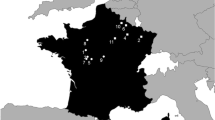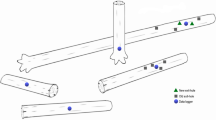Abstract
Species-specific densities of saproxylic beetles in cut 4-m high, medium to large diameter stumps of spruce, birch, aspen and oak were monitored for 7 years after cutting, by trapping emerging insects within seasonally applied net enclosures. A total of 47,038 individuals, representing 316 saproxylic beetle species including 40 red-listed species, were recorded. Densities of 86 species were modelled in relation to stump diameter and measured levels of sun-exposure. Two thirds of the species favoured semi- or fully exposed substrates, while one third performed better in shade. Few species seemed to be specifically adapted to semi-exposed conditions. Diameter was generally of less importance than exposure, and similar numbers of species favoured medium and large diameter substrates. Group mean diameter and exposure calculated from means per individual and species were similar for groups of modelled and non-modelled species, and for groups of red-listed and non-red-listed species, respectively. This indicates that the proportions found in the models are representative for the diverse regional fauna of saproxylic beetles that utilise high stumps of spruce, birch, aspen and oak in early stages of decay. The results suggest that sun-exposed dead wood substrates generated and retained in managed forest landscapes are potentially important for many species. However, stands of unmanaged self-thinning successions of deciduous trees, as well as substantial areas of old-growth spruce-forests are also necessary to address the wide spectrum of saproxylic beetles.
Similar content being viewed by others
References
H. Ahnlund (1996) ArticleTitleSaproxylic insects on a Swedish dead aspen Entomologisk Tidskrift 117 137–144
H. Ahnlund A. Lindhe (1992) ArticleTitleEndangered wood-living insects in coniferous forests – some thoughts from studies of forest-fire sites, outcrops and clear-cuttings in the province of Sörmland Sweden Entomologisk Tidskrift 113 13–23
T. Ahti L. Hämet-Ahti J. Jalas (1968) ArticleTitleVegetation zones and their sections in north-western Europe Annales Botanici Fennici 5 169–211
Anon. (1998) Swedish FSC Standard for Forest Certification The Swedish FSC Council Uppsala, Sweden
A. Bakke T. Kvamme (1993) ArticleTitleBeetles attracted to Norway Spruce under attack by Ipstypographus Communication of Norwegian Forest Research Institute 45 1–24
Å. Berg B. Ehnström L. Gustafsson T. Hallingbäck M. Jonsell J. Weslien (1994) ArticleTitleThreatened plant, animal and fungus species in Swedish forests: distribution and habitat associations Conserv. Biol. 8 718–731 Occurrence Handle10.1046/j.1523-1739.1994.08030718.x
B. Ehnström B. Långström C. Hellqvist (1995) ArticleTitleInsects in burned forests – forest protection and faunal conservation (preliminary results) Entomologica Fennica 5 109–117
J. Fridman M. Walheim (2000) ArticleTitleAmount structure and dynamics of dead wood on managed forest land in Sweden Forest Ecol. Manage. 131 23–36 Occurrence Handle10.1016/S0378-1127(99)00208-X
U. Gärdenfors (Eds) (2000) Rödlistade arter i Sverige 2000 – The 2000 Red List of Swedish Species ArtDatabanken SLU, Sweden
U. Gärdenfors R. Baranowski (1992) ArticleTitleBeetles living in open deciduous forests prefer different tree species than those living in dense forests Entomologisk Tidskrift 113 1–11
E. Göthlin L.M. Schroeder Å. Lindelöw (2000) ArticleTitleAttacks by Ips typographus and Pityogenes chalcographus on windthdrown sprauces (Picea abies) during two years following the storm felling Scandinavian Journal of Forest Research 15 542–549 Occurrence Handle10.1080/028275800750173492
P.O. Hedgren J. Weslien L.M. Schroeder (2003 (a)) ArticleTitleRisk of attack by the bark beetle Pityogenes chalcographus (L.) on living trees close to colonised felled spruce trees Scandinavian Journal of Forest Research 18 39–44 Occurrence Handle10.1080/0891060310002327
P.O. Hedgren L.M.. Schroeder J. Weslien (2003 (b)) ArticleTitleTree killing by Ips typographus (Coleoptera: Scolytidae) at stand edges with and without colonised felled spruces trees Agricultural and Forest Entomology 5 67–74 Occurrence Handle10.1046/j.1461-9563.2003.00164.x
Jonsell M., Nittérus K. and Stighäll K. Saproxylic beetles in natural and man-made deciduous high stumps retained for conservation. Biol. Conserv. 118: 163–173.
M. Jonsell G. Nordlander B. Ehnström (2001) ArticleTitleSubstrate preferences of insects breeding in wood decaying fungi Ecol. Bull. 49 173–194
M. Jonsell J. Weslien B. Ehnström (1998) ArticleTitleSubstrate requirements of red-listed saproxylic invertebrates in Sweden Biodiv. Conserv. 7 749–764 Occurrence Handle10.1023/A:1008888319031
L. Kaila P. Martikainen P. Punttila (1997) ArticleTitleDead trees left in clear-cuts benefit saproxylic Coleoptera adapted to natural disturbances in boreal forest Biodiv. Conserv. 6 1–18 Occurrence Handle10.1023/A:1018399401248
D.B. Lindenmayer J.F. Franklin (2002) Conserving Forest Biodiversity. A Comprehensive Multiscaled Approach Island Press Washington, DC
P. Linder (1998) ArticleTitleStructural changes in two virgin boreal forest stands in central Sweden over 72 years Scand. J. Forest Res. 13 451–461
P. Linder L. Östlund (1998) ArticleTitleStructural change in three mid-boreal Swedish forest landscapes 1885–1996 Biol. Conserv. 85 9–19 Occurrence Handle10.1016/S0006-3207(97)00168-7
S. Lundberg (1984) ArticleTitleThe beetle fauna of burnt forests in Sweden Entomologisk Tidskrift 105 129–141
S. Lundberg (1995) Catalogus Coleoptorum Sueciae Naturhistoriska Riksmuseet StockholmSweden
P. Martikainen (2001) ArticleTitleConservation of threatened saproxylic beetles: significance of retained aspen Populus tremula on clearcut areas Ecol. Bull. 49 205–218
P. Martikainen J. Siitonen L. Kailla P. Punttila J. Rauh (1999) ArticleTitleBark beetles (Coleoptera Scolytidae) and associated beetle species in mature managed and old-growth boreal forests in southern Finland Forest Ecology and Management 116 233–245 Occurrence Handle10.1016/S0378-1127(98)00462-9
M. Moretti S. Barbalat (2004) ArticleTitleThe effects of wildfires on wood-eating beetles in deciduous forests on the southern slope of the Swiss alps Forest Ecol. Manage. 187 85–103 Occurrence Handle10.1016/S0378-1127(03)00314-1
J. Niemelä (1996) ArticleTitleInvertebrates and boreal forest management Conserv. Biol. 11 601–610 Occurrence Handle10.1046/j.1523-1739.1997.06008.x
J. Niemelä (1999) ArticleTitleManagement in relation to disturbance in the boreal forest Forest Ecol. Manage. 115 127–134 Occurrence Handle10.1016/S0378-1127(98)00393-4
S.G. Nilsson (1997) ArticleTitleForests in the temperate-boreal transition: natural and man-made features Ecol. Bull. 46 61–71
S.G. Nilsson M. Niklasson J. Hedin G. Aronsson J.M. Gutowski P. Linder H. Ljungberg G. Mikusiski T. Ranius (2002) ArticleTitleDensities of large and dead trees in old-growth temperate and boreal forests Forest Ecol. Manage. 161 189–204 Occurrence Handle10.1016/S0378-1127(01)00480-7
B. Økland (1996) ArticleTitleUnlogged forests: important sites for preserving the diversity of mycetophilids (Diptera: Sciaroidea) Biol. Conserv. 76 297–310 Occurrence Handle10.1016/0006-3207(95)00129-8
B. Økland (2002) ArticleTitleCanopy cover favours sporocarp-visiting beetles in spruce forest Norwegian J. Entomol. 49 29–39
U. Olsson (2002) Generalized linear models: an applied approach Studentlitteratur Lund Sweden
T. Palm (1951) ArticleTitleDie Holz- und Rinden-Käfer der nordschwedischen Laubbäume Meddelanden från Statens Skogsforskningsinstitut 40 1–242
T. Palm (1959) ArticleTitleDie Holz- und Rinden-Käfer der süd- und mittelschwedischen Laubbäume Opuscula Entomologica Supplement XVI 1–374
M. Peltonen K. Heliövaara R. Väisänen (1997) ArticleTitleForest insects and environmental variation in stand edges Silva Fennica 31 129–141
T. Ranius N. Jansson (2000) ArticleTitleThe influence of forest regrowth original canopy cover and tree size on saproxylic beetles associated with old oaks Biol. Conserv. 95 85–94 Occurrence Handle10.1016/S0006-3207(00)00007-0
P. Renvall (1995) ArticleTitleCommunity structure and dynamics of wood-rotting Basidiomycetes on decomposing conifer trunks in northern Finland Karstenia 35 1–51
U. Saalas (1917) Die Fichtenkäfer Finnlands I. Suomalaisen Tiedekatemian Kustantama Helsinki Finland
J. Siitonen R. Penttilä H. Kotiranta (2001) ArticleTitleCoarse woody debris, polyporous fungi and saproxylic insects in an old-growth spruce forest in Vodlozero National Park, Russian Karelia Ecol. Bull. 49 231–242
J. Siitonen L. Saaristo (2000) ArticleTitleHabitat requirements and conservation of Pytho kolwensis a beetle species of old-growth boreal forest Biol. Conserv. 94 11–220 Occurrence Handle10.1016/S0006-3207(99)00174-3
M. Similä J. Kouki P. Martikainen A. Uotila (2002) ArticleTitleConservation of beetles in boreal pine forests: the effects of forest age and naturalness on species assemblages Biol. Conserv. 106 19–27 Occurrence Handle10.1016/S0006-3207(01)00225-7
L. Söderström (1987) The regulation of abundance and distribution patterns of bryophyte species on decaying logs in spruce forests. Doctoral dissertation University of Umeå Sweden
A. Sverdrup-Thygeson R.A. Ims (2002) ArticleTitleThe effect of clear-cutting on the community of saproxylic beetles on aspen Biol. Conserv. 106 347–357 Occurrence Handle10.1016/S0006-3207(01)00261-0
L. Tibell (1992) ArticleTitleCrustose lichens as indicators of forest continuity in boreal coniferous forests Nordic J. Bot. 12 427–450
L.-O. Wikars (1992) ArticleTitleForest fires and insects Entomologisk Tidskrift 113 1–11
L.-O. Wikars (1997) ArticleTitleFire-dependent insects in Orsa Finnmark: biology, distribution and conservation Entomologisk Tidskrift 118 155–169
L.-O. Wikars (2002) ArticleTitleDependence on fire in wood-living insects: an experiment with burned and unburned spruce and birch logs J. Insect Conserv. 6 1–12 Occurrence Handle10.1023/A:1015734630309
O. Zakrisson (1977) ArticleTitleInfluence of forest fires on the north Swedish boreal forest Oikos 29 22–32
Author information
Authors and Affiliations
Corresponding author
Rights and permissions
About this article
Cite this article
Lindhe, A., Lindelöw, Å. & Åsenblad, N. Saproxylic Beetles in Standing Dead Wood Density in Relation to Substrate Sun-exposure and Diameter. Biodivers Conserv 14, 3033–3053 (2005). https://doi.org/10.1007/s10531-004-0314-y
Received:
Accepted:
Issue Date:
DOI: https://doi.org/10.1007/s10531-004-0314-y




